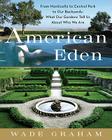 American Eden
American EdenThe story of our nation and ourselves—as told through our country's most significant gardens and their creators
From Frederick Law Olmsted to Richard Neutra, Michelle Obama to our neighbors, Americans throughout history have revealed something of themselves—their personalities, desires, and beliefs—in the gardens they create. Rooted in the time and place of their making, as much as in the minds and identities of their makers, gardens mirror the struggles and energies of a changing society. Melding biography, history, and cultural commentary in a one-of-a-kind narrative, American Eden presents a dynamic, sweeping look at this country's landscapes and the visionaries behind them.
Monticello's gardens helped Jefferson reconcile his conflicted feelings about slavery—and take his mind off his increasing debt. Edith Wharton's gardens made her feel more European and superior to her wealthy but insufficiently sophisticated countrymen. Martha Stewart's how-to instructions helped bring Americans back into their gardens, while at the same time stoking and exploiting our anxieties about social class. Isamu Noguchi's and Robert Smithson's experiments reinvigorated the age-old exchange between art and the garden.
American Eden offers an inclusive definition of the garden, considering intentional landscapes that range from domestic kitchen gardens to city parks and national parks, suburban backyards and golf courses, public plazas and Manhattan's High Line park, reclaimed from freight train tracks. And it exposes the overlap between garden-making and painting, literature, and especially architecture—the garden's inseparable sibling—to reveal the deep interconnections between the arts and their most inspired practitioners.
Moving deftly through time and place across America's diverse landscapes—from Revolutionary-era Virginia to turn-of-the-century Chicago to 1960s suburban California—and featuring a diverse cast of landscape-makers—whether artists, architects, or housewives, amateurs or professionals, robber barons, politicians, reformers, or dreamers—Wade Graham vividly unfolds the larger cultural history through more personal dramas.
Beautifully illustrated with color and black-and-white images, American Eden is at once a different kind of garden book and a different kind of American history, one that offers a compelling, untold story—a saga that mirrors and illuminates our nation's invention, and constant reinvention, of itself.
 Founding Gardeners
Founding GardenersFrom the author of the acclaimed The Brother Gardeners {see below}, a fascinating look at the founding fathers from the unique and intimate perspective of their lives as gardeners, plantsmen, and farmers.
For the founding fathers, gardening, agriculture, and botany were elemental passions, as deeply ingrained in their characters as their belief in liberty for the nation they were creating. Andrea Wulf reveals for the first time this aspect of the revolutionary generation. She describes how, even as British ships gathered off Staten Island, George Washington wrote his estate manager about the garden at Mount Vernon; how a tour of English gardens renewed Thomas Jefferson’s and John Adams’s faith in their fledgling nation; how a trip to the great botanist John Bartram’s garden helped the delegates of the Constitutional Congress break their deadlock; and why James Madison is the forgotten father of American environmentalism. These and other stories reveal a guiding but previously overlooked ideology of the American Revolution.
Founding Gardeners adds depth and nuance to our understanding of the American experiment and provides us with a portrait of the founding fathers as they’ve never before been seen.
 The Brother's Garden
The Brother's GardenBringing to life the science and adventure of eighteenth-century plant collecting, The Brother Gardeners is the story of how six men created the modern garden and changed the horticultural world in the process. It is a story of a garden revolution that began in America.
In 1733, colonial farmer John Bartram shipped two boxes of precious American plants and seeds to Peter Collinson in London. Around these men formed the nucleus of a botany movement, which included famous Swedish botanist Carl Linnaeus; Philip Miller, bestselling author of The Gardeners Dictionary; and Joseph Banks and David Solander, two botanist explorers, who scoured the globe for plant life aboard Captain Cook’s Endeavor. As they cultivated exotic blooms from around the world, they helped make Britain an epicenter of horticultural and botanical expertise. The Brother Gardeners paints a vivid portrait of an emerging world of knowledge and gardening as we know it today.
 The Curious Gardener's Almanac
The Curious Gardener's AlmanacA delightful anthology of curiosities that honors the gardening life.
Celebrating the garden in all its splendid diversity and rich history, this collection of facts, ancient wisdom and customs, tips, and recipes features more than 1,000 entries-remarkable information about flowers, vegetables, fruits, trees, herbs, insects, birds, water, soil, tools, composts, climate, gardens and gardeners, myths, superstitions, and biodynamics.
Woven into this wealth of knowledge are famous quotations, anecdotes, traditional sayings, lines of verse, and words of rural wisdom. It's a wonderful gift for any gardener, whether they're tending a window box or a full-fledged farm.
1 comment:
Really great reviews of the books.These books sound good and explain all the knowledge and aspects which is concern with the garden as well gardening.I am beginner and these books help me in learning all pros and cons related to garden.
Post a Comment